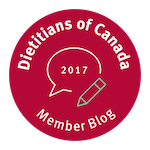Is Health Canada saying we should throw out the current Food Guide because we’ve had it all wrong until now? Let’s take a closer look.
“Have you seen the new Food Guide? Everything’s changing!” Sound familiar? I’ve heard mention of this from teachers, parents, and friends for months. To be clear, Canada does not have a new Food Guide—yet. In the spring of 2017, Health Canada released preliminary draft guiding principles1 for our future Food Guide. Is Health Canada saying we should throw out the current Food Guide because we’ve had it all wrong until now? Let’s take a closer look.
Then and now: What’s changed since the first Food Guide in 1942?
Canada released the “Official Food Rules” 75 years ago. These “rules” emphasized milk, fruits, vegetables, cereals and bread, meat, fish, etc. and eggs,2 which continue to be foundational foods today. The divisions were a little different, but nearly all the foods mentioned in the first guide exist in Health Canada’s current guidelines; they still help Canadians meet their nutrient needs and decrease the risk for developing chronic disease.3
An interesting fact: in 1942 there was mention of “meat substitutes”, but the associated food group was titled “Meat, fish, etc.” There was also mention of eating a citrus fruit and leafy greens daily. Whole grains were encouraged, as was including sources of vitamin D. Again, fast forward to today and much remains the same.
Saying everything has changed draws the media’s attention, but that’s simply not the case. Speaking about the draft guidelines, the Director General of the Office of Nutrition Policy and Promotion was quoted recently as saying, “In reality, in my mind this is not very different than what [the current Food Guide] is.”4 With this being said, it’s important to understand what Canadians are currently eating.
Do Canadians follow Health Canada’s eating advice?

In short, no. Health Canada’s 2015 evidence review5 revealed Canadians fall short in eight key nutrients: calcium, magnesium, zinc, vitamin C, vitamin A, vitamin D, potassium, and fibre. Where are these nutrients found? In the four main areas Canadians typically under consume:
- Vegetables & fruit (vitamin A, vitamin C & fibre)
- Whole grains (magnesium, zinc, potassium & fibre)
- Milk products and/or fortified soy but NOT fortified almond, hemp, coconut etc. beverages (calcium, magnesium, zinc, vitamin A, vitamin D, & potassium)
- Meat alternatives such as beans, lentils, tofu, nuts, seeds etc. (magnesium, zinc, potassium & fibre)
In an effort to encourage Canadians to eat more plant-based protein sources, our current Food Guide, released in 2007, promotes meat alternatives such as beans, lentils, and tofu alongside a message to make at least half your daily grain choices whole grains.

The draft guidelines released in 2017 have put further emphasis on plant-based protein. Why? Canadians simply aren’t eating beans, lentils, tofu, nuts, seeds and whole grains often. There is research that points to the health benefits, cost savings, and decreased environmental impact of including foods from plant-based protein sources alongside animal sources.
So what’s the buzz about dairy?
I have also heard mention that dairy is out of the guidelines. Again, this is not true. The draft guiding principles did not suggest dairy should be excluded from the future Food Guide. Yes, Health Canada wants us to eat more plant-based protein sources and I agree wholeheartedly, but they also recognize the value and importance that dairy plays in people’s lives, especially for growing children. Dairy products are an excellent source of protein and six of the eight key nutrients Canadians lack in their diets5.
The bottom line
Health Canada will use the draft guiding principles and the input from the recent national consultation to inform the release of national healthy eating guidelines, scheduled for 2018. A new food guide should follow in 2019. I look forward to learning how the new Food Guide will be packaged to market a healthy pattern of eating that fits with the preferences, availability, culture, environmental, and financial considerations of Canadians. In the meantime, we don’t need to worry that we’re without guidance because our current guidelines continue to be the trusted source of information on healthy eating.

References
- https://www.foodguideconsultation.ca/guiding-principles-detailed Accessed October 19, 2017
- https://www.canada.ca/en/health-canada/services/food-nutrition/canada-food-guide/background-food-guide/canada-food-guides-1942-1992.html Accessed October 19, 2017
- https://www.canada.ca/en/health-canada/services/food-nutrition/healthy-eating/dietary-reference-intakes/consumer-guide-dris-dietary-reference-intakes.html Accessed October 19, 2017
- http://nationalpost.com/health/health-canada-prepares-to-rewrite-the-food-guide Accessed October 19, 2017
- https://www.canada.ca/en/health-canada/services/publications/food-nutrition/evidence-review-dietary-guidance-summary-results-implications-canada-food-guide.html#s3 Accessed October 19, 2017
